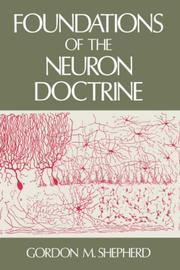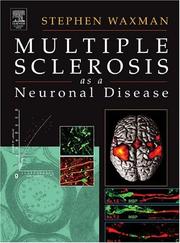| Listing 1 - 10 of 96 | << page >> |
Sort by
|

ISBN: 1280969555 9786610969555 0387708308 0387708294 Year: 2007 Publisher: New York ; London : Springer,
Abstract | Keywords | Export | Availability | Bookmark
 Loading...
Loading...Choose an application
- Reference Manager
- EndNote
- RefWorks (Direct export to RefWorks)
Interactions Between Neurons and Glia in Aging and Disease is an indispensable source of reference reviews and concise overviews of the functional cross-talk between neurons and glial cells. This key title specifically focuses on microglia and inflammation in the aging brain and in neurological disorders. The subject material covered by the book is a crucial competitive area with critical implications for human health and will be of key interest to the scientific community. Interactions Between Neurons and Glia in Aging and Disease is broken into three main sections to help guide the reader from the basic functional cross-talk between neuron and glia to brain pathology. Neuroimmunity and neuroinflammation Signalling and inflammation in aging Neurodegeneration and inflammation in age related diseases This unique volume will be invaluable not only to those interested in neuroscience, but also cell biology, molecular biology, biochemistry, and pharmaceutical sciences.
Geriatric neurology. --- Astrocytes. --- Neurons. --- Nerve cells --- Neurocytes --- Cells --- Nervous system --- Glia (Neurology) --- Neuroglia --- Geriatrics --- Neurology
Book
ISBN: 1789851246 1789851238 1839620390 Year: 2019 Publisher: IntechOpen
Abstract | Keywords | Export | Availability | Bookmark
 Loading...
Loading...Choose an application
- Reference Manager
- EndNote
- RefWorks (Direct export to RefWorks)
The brain is the most complex structure that exists in the universe, consisting of neurons whose function is to receive information through dendrites and transmit information through the axon. In neurosciences one of the main problems that exists are neurodegenerative diseases for which until now there has been no cure. This book is mainly focused on updating the information on the signaling process carried out in the development of axons. Topics such as axon guidance and its interaction with the extracellular matrix are discussed. Other important topics are semaphorins and their relationship with neurodegenerative diseases, and the neurobiology of the gap junction in the dorsal root ganglion. Finally, the topic of bioelectrical interfaces destined to regenerate damaged nerves is covered. The information in this book will be very important both for researchers who work with these issues and doctoral students who are involved in neuroscience.
Neurons. --- Nerve cells --- Neurocytes --- Cells --- Nervous system --- Life Sciences --- Neuroscience --- Neurobiology

ISBN: 1860944043 9781860944048 1860940307 1860940366 9781860940309 Year: 1996 Publisher: London River Edge, NJ Imperial College Press Distributed by World Scientific Pub. Co.
Abstract | Keywords | Export | Availability | Bookmark
 Loading...
Loading...Choose an application
- Reference Manager
- EndNote
- RefWorks (Direct export to RefWorks)
Impossible Minds: My Neurons, My Consciousness has been written to satisfy the curiosity each and every one of us has about our own consciousness. It takes the view that the neurons in our heads are the source of consciousness and attempts to explain how this happens. Although it talks of neural networks, it explains what they are and what they do, in such a way that anyone may understand.This book is also a story. A story of a land where people think that they are automata without much in the way of consciousness, a story of cormorants and cliffs by the sea, a story of what it might be like t
Brain. --- Neurons. --- Nerve cells --- Neurocytes --- Cells --- Nervous system --- Cerebrum --- Mind --- Central nervous system --- Head

ISBN: 0195064917 9780195064919 Year: 1991 Volume: 6 Publisher: New York : Oxford University Press,
Abstract | Keywords | Export | Availability | Bookmark
 Loading...
Loading...Choose an application
- Reference Manager
- EndNote
- RefWorks (Direct export to RefWorks)
Neuroanatomy --- Neurons --- Neurology --- Neurologie --- History --- Histoire --- Neuroanatomie --- Neurons. --- Nerve Cells --- Cell, Nerve --- Cells, Nerve --- Nerve Cell --- Neuron --- Nerve cells --- Neurocytes --- Cells --- Nervous system --- Nerves --- Anatomy --- Neurobiology --- History. --- history. --- history --- Neuroanatomy - History. --- Neurons - History.
Periodical
Abstract | Keywords | Export | Availability | Bookmark
 Loading...
Loading...Choose an application
- Reference Manager
- EndNote
- RefWorks (Direct export to RefWorks)
Neurons --- Neurons. --- Neurophysiologie --- Nervenzelle --- Zeitschrift --- Periodikum --- Zeitschriften --- Presse --- Fortlaufendes Sammelwerk --- Ganglienzelle --- Neurozyt --- Neuron --- Zelle --- Paraneuron --- Nerve cells --- Neurocytes --- Cells --- Nervous system --- Nervenphysiologie --- Nervensystem --- Neurologie --- Physiologie --- Hirnforschung --- Nerve Cells --- Cell, Nerve --- Cells, Nerve --- Nerve Cell --- Neurones --- Neurobiologia molecular --- Neurofisiologia
Book
ISBN: 1283850699 9814350451 9789814350457 9789814350440 9814350443 9781283850698 Year: 2012 Publisher: Singapore World Scientific
Abstract | Keywords | Export | Availability | Bookmark
 Loading...
Loading...Choose an application
- Reference Manager
- EndNote
- RefWorks (Direct export to RefWorks)
What is autophagy? Why would neurons digest parts of themselves through autophagy? How can autophagy save the lives of cells under some conditions, but act as an accomplice to cell death in others? By what mechanisms are autophagy-related processes dysregulated in neurological diseases, and are there therapeutic strategies to correct or compensate for their dysfunction? This book provides an expert view of major concepts in autophagy research with a focus on autophagy in neurons. Experimental evidence for evolutionarily conserved and specialized regulatory mechanisms for autophagy in the mamma
Nervous system --- Neurons. --- Medical neurology --- Nerves --- Neurologic disorders --- Neurological disorders --- Neuropathology --- Neurology --- Nerve cells --- Neurocytes --- Cells --- Diseases. --- Diseases
Book
ISBN: 0773597328 9780773597327 9780773597334 0773597336 9780773545717 0773545719 Year: 2015 Publisher: Montreal Kingston London Chicago
Abstract | Keywords | Export | Availability | Bookmark
 Loading...
Loading...Choose an application
- Reference Manager
- EndNote
- RefWorks (Direct export to RefWorks)
In science, sometimes it is best to keep things simple. Initially discrediting the discovery of neurons in jellyfish, mid-nineteenth-century scientists grouped jellyfish, comb-jellies, hydra, and sea anemones together under one term - "coelenterates" - and deemed these animals too similar to plants to warrant a nervous system. In Dawn of the Neuron, Michel Anctil shows how Darwin's theory of evolution completely eradicated this idea and cleared the way for the modern study of the neuron. Once zoologists accepted the notion that varying levels of animal complexity could evolve, they began to use simple-structured creatures such as coelenterates and sponges to understand the building blocks of more complicated nervous systems. Dawn of the Neuron provides fascinating insights into the labours and lives of scientists who studied coelenterate nervous systems over several generations, and who approached the puzzling origin of the first nerve cells through the process outlined in evolutionary theory. Anctil also reveals how these scientists, who were willing to embrace improved and paradigm-changing scientific methods, still revealed their cultural backgrounds, their societal biases, and their attachments to schools of thought and academic traditions while presenting their ground-breaking work. Their attitudes toward the neuron doctrine - where neurons are individual, self-contained cells - proved decisive in the exploration of how neurons first emerged. Featuring photographs and historical sketches to illustrate this quest for knowledge, Dawn of the Neuron is a remarkably in-depth exploration of the link between Darwin's theory of evolution and pioneering studies and understandings of the first evolved nervous systems
Nervous system. --- Neurophysiology --- Neuroanatomy --- Neurons --- Nerves --- Nervous system --- Anatomy --- Neurobiology --- Physiology --- Organs (Anatomy) --- Neurosciences --- Nerve cells --- Neurocytes --- Cells --- History.
Book
ISBN: 0674967488 0674735641 9780674735644 9780674599215 0674599217 Year: 2014 Publisher: Cambridge, MA : Harvard University Press,
Abstract | Keywords | Export | Availability | Bookmark
 Loading...
Loading...Choose an application
- Reference Manager
- EndNote
- RefWorks (Direct export to RefWorks)
Molecular and Cellular Physiology of Neurons, Second Edition is a comprehensive, up-to-date introduction to essential concepts of cellular neuroscience. Emphasizing experimental approaches and recent discoveries, it provides an in-depth look at the structure and function of nerve cells, from protein receptors and synapses to the biochemical processes that drive the mammalian nervous system. Starting with the basics of electrical current flow across cell membranes, Gordon Fain covers voltage gating and receptor activation in the context of channel diversity, excitatory and inhibitory synaptic transmission, neuromodulation, and sensory transduction. Emphasizing long-term processes of synaptic potentiation and depression involved in memory, consciousness, and attention, he demonstrates how cells produce neural signals and regulate signal flow to enhance or impede cell-to-cell communication. Fain also addresses the relation of molecular and cellular mechanisms to evolving theories of neurological disease and addiction. Enhanced by more than two hundred illustrations, Molecular and Cellular Physiology of Neurons, Second Edition is intended for anyone who seeks to understand the fundamentals of nerve cell function, including undergraduate and graduate students in neuroscience, students of bioengineering and cognitive science, and practicing neuroscientists who want to deepen their knowledge of recent discoveries in molecular and cellular neurophysiology.
Neurophysiology. --- Neurons. --- Molecular neurobiology. --- Molecular neurology --- Nervous system --- Molecular biology --- Neurobiology --- Nerve cells --- Neurocytes --- Cells --- Physiology --- Molecular aspects
Book
ISBN: 0444802029 Year: 1980 Publisher: Amsterdam North-Holland
Abstract | Keywords | Export | Availability | Bookmark
 Loading...
Loading...Choose an application
- Reference Manager
- EndNote
- RefWorks (Direct export to RefWorks)
Cell Membrane --- Neurons --- Cell membranes --- Nerve cells --- Neurocytes --- Cells --- Nervous system --- Cell surfaces --- Cytoplasmic membranes --- Plasma membranes --- Plasmalemma --- Membranes (Biology) --- physiology. --- Glycocalyces --- physiology --- Cell membranes. --- Cell Membrane.

ISBN: 0127387617 9780127387611 9780080489414 0080489419 1281052744 9781281052742 9786611052744 6611052747 Year: 2005 Publisher: Burlington, MA : Elsevier Academic Press,
Abstract | Keywords | Export | Availability | Bookmark
 Loading...
Loading...Choose an application
- Reference Manager
- EndNote
- RefWorks (Direct export to RefWorks)
This book examines the role of neurons in multiple sclerosis (MS) and the changes that occur in neurons as a result of MS. It places MS in a new and important perspective that not only explains the basis for symptom production, remission, and progress in MS, but also promises to open up new therapeutic possibilities.* Brings together the latest information from clinical, pathological, imaging, molecular, and pharmacological realms to explore the neurobiology of Multiple Sclerosis* Places MS in a new and important perspective that promises to open up new therapeutic avenues* Sup
Neuropathology --- MS --- Neurologie --- Multiple sclerosis --- Neurons. --- Nerve cells --- Neurocytes --- Cells --- Nervous system --- MS (Disease) --- Sclerosis, Multiple --- Demyelination --- Myelin sheath --- Virus diseases --- Pathophysiology. --- Diseases
| Listing 1 - 10 of 96 | << page >> |
Sort by
|

 Search
Search Feedback
Feedback About UniCat
About UniCat  Help
Help News
News